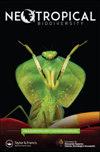¿Cómo avanzar en la conservación de los bosques de Polylepis y su diversidad biológica?
IF 0.8
Q4 ECOLOGY
引用次数: 3
Abstract
ABSTRACT Polylepis is the dominant genus of the high Andean forest vegetation and they have a crucial ecological role. However, these forests are highly endangered and many of their biological aspects are still unknown. In this context, a series of questions were formulated with the aim that their resolution would contribute to a better understanding of Polylepis’dynamics and biological diversity, as well as improve their conservation efforts. Twenty one speakers from the V International Congress of Conservation and Ecology of Polylepis forests participated in the formulation of 67 questions related to these forests. Comments and additional information were received via email and google doc spreadsheet, open to the participants. Afterwards, two workshops were organized with the researchers to formulate, discuss, analyze and define the final list, narrowing down to a total of 40 questions. The questions were categorized into 6 different topics: Taxonomy, Ecology and Biogeography, Genetics, Conservation, Ethnobiology and Climate Change. We hope these questions will be considered as a priority for new research agendas and to define joint efforts for Polylepis forest conservation.如何在保护Polylepis森林及其生物多样性方面取得进展?
摘要:Polylepis是安第斯高山森林植被的优势属,具有重要的生态作用。然而,这些森林高度濒危,其许多生物学方面仍然未知。在此背景下,提出了一系列问题,目的是解决这些问题将有助于更好地了解多聚体的动力学和生物多样性,并改进其保护工作。来自第五届国际保护和生态保护大会的21位发言者参与了67个与这些森林有关的问题的拟订工作。通过向参与者开放的电子邮件和谷歌文档电子表格收到了评论和其他信息。之后,与研究人员一起组织了两次研讨会,以制定、讨论、分析和定义最终清单,总共减少到40个问题。这些问题分为6个不同的主题:分类学、生态学和生物地理学、遗传学、保护学、民族生物学和气候变化。我们希望这些问题将被视为新研究议程的优先事项,并确定为保护Polylapis森林所做的共同努力。
本文章由计算机程序翻译,如有差异,请以英文原文为准。
求助全文
约1分钟内获得全文
求助全文
来源期刊

Neotropical Biodiversity
Environmental Science-Ecology
CiteScore
1.80
自引率
0.00%
发文量
39
审稿时长
24 weeks
 求助内容:
求助内容: 应助结果提醒方式:
应助结果提醒方式:


